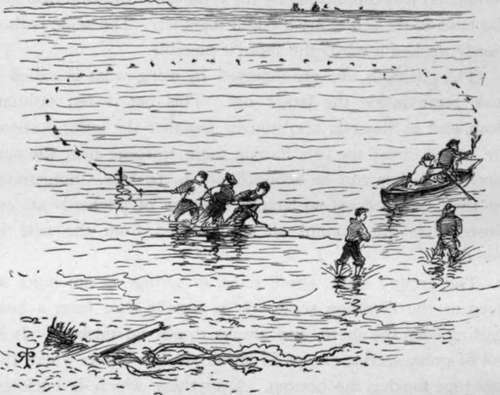Sea Fishing From Yachts And Large Fishing Boats. Part 11
Description
This section is from the book "Sea Fishing", by John Bickerdyke. Also available from Amazon: Sea Fishing.
Sea Fishing From Yachts And Large Fishing Boats. Part 11
The pilchards, etc. are removed by using what is called a tuck seine inside the larger net. This net is ten fathoms deep, and as its ends are brought together the lower portions are raised under the fish, forcing them to come near the surface, when they can be scooped out in baskets. Sometimes on the Cornish coast so large a quantity of pilchards are enclosed that they cannot all be removed from the nets in one day.
The ground seine, shore seine, or scringe is not quite so deep as the common seine. It is usually shot from a boat starting from the shore, and always drawn up on land. It is not of great service except in those shallow waters where the foot rope touches the bottom. Everything which is enclosed and cannot pass through the meshes is caught, though maybe the foot rope misses a few flat fish lying hidden in the sand. The net, after being shot and both ends brought on shore, should be dragged in gradually and evenly from both sides, the men who are working it approaching one another until they meet, when the bottom ropes can be laid side by side, with the result that the bunt or centre of the net comes under the fish which have been encircled by it. Of course, with surface-swimming fish the scringe or ground seine need not touch the bottom. Many visitors to the seaside have doubtless seen these nets used for encircling mackerel during the summer months.
It is a curious fact that in the early part of the century the use of the seine net for encircling shoals of herrings was so much opposed in Scotland by the drift-net fishermen that Parliament actually prohibited its employment. The fact seems to have been not that the herring fisheries were in any way injured by the nets, or seine trawls, as they were called, but that the enormous takes of herrings which were sometimes made by their means glutted the market from time to time, and reduced fish to a price which was anything but pleasant to the drift-net fishermen whose takes were more regular. A royal commission sat and inquired, and for once in a while something came of it, for the exceedingly stupid legislation on the subject was repealed.

SHORE SEINE OR SCRINGE.
Seine nets for sand-eels are illustrated on p. 118.
Yacht-owners very frequently, and with great wisdom, carry lobster and prawn pots. These also are dealt with in a separate chapter.
I think yachtsmen who do not fish for the market might very well limit their use of nets to capturing just so much food as they require for the table or for their friends or for scientific purposes. By exclusive or indiscriminate netting they run the risk of injuring not only the livelihood of the poorer classes of fishermen who own small open boats and set their lines near the shore, but also the comparatively new branch of angling which unquestionably will, in the course of time, take thousands from our overstocked rivers and lakes, and provide them with inexpensive, healthy and profitable amusement off our coasts.
I have to acknowledge the loan by Mr. Hearder, of Plymouth, of trawl and trammel nets, floating trot, etc, from which the illustrations in this chapter were made.
Note.—Only a few days before the publication of this book, and therefore too late for more than this short notice, there appears a most important report on ' Trawling in the North Sea,' with special reference to the destruction of immature fish, by E. W. L. Holt. It is issued as a special number of the ' Journal' of the Marine Biological Association, and I earnestly commend it to the attention of all those interested in the preservation of sea fish.
Continue to:
- prev: Sea Fishing From Yachts And Large Fishing Boats. Part 10
- Table of Contents
- next: Chapter IX. The Ocean Fishing Rod
Tags
fishing, hooks, bait, fishermen, spanish mackerel, mackerel fishing
